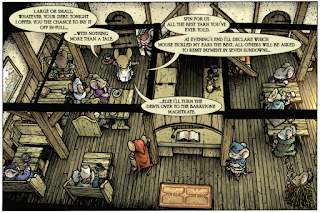Alchemy, in the D&D sense, is practically unknown on Carcosa. Potions generally do not exist. What fills the same niche is baking - a complex, spiritual and potentially dangerous practice.
Fungi on Carcosa are imbued with magical properties, particularly the brain-parasitic
fungi from Yuggoth. Another branch of the same family tree (or family mycelium, rather) are the magical yeasts. Baker-shamans jealously guard their yeast starters, passing them down through generations. Under rare moons they come together in a bakersmoot, to trade and breed new strains.
On Earth, wheat has had an incredible impact on human culture.
Arguably, wheat domesticated humans rather than the other way around. Some ancient alien theorists even speculate that emmer wheat was given to humans by extraterrestrials to jump-start agrarian civilisation. But on Carcosa, wheat is rare. Most human tribes are hunter-gatherers or fungal agriculturalists. Wild wheatfields grow only in remote locations, and those who know them keep them secret.
Yeasts and wheat come together in the alchemical ritual of baking. The resulting loaves can be consumed for a variety of effects, depending on the particular strain of yeast. Unlike potions, loaves take around 10 minutes to consume and are typically shared between a group of characters. Here are six samples:
1. Purple Nutbread. Made from kamut wheat, nuts and the yeast strain "The Incomparable Scion". Those who eat this bread together will be fused into a fleshy monstrosity, with all the abilities of all characters plus 1d6 beneficial mutations. They will dissolve from each other under the new moon, although sometimes ending up with mismatched limbs, eyes, etc.
2. Loaf of Fealty. Orange bread made from spelt and the yeast strain "Son and Daughter". To activate this bread, one person must break the loaf and drip their blood onto it. Those who eat the bread become bound to serve the one whose blood was offered. The eaters grow stronger, faster and more hale, while the blood-offerer becomes weak and sickly in proportion. These effects are permanent.
3. Cavitaceous Loaf. Pale grey bread, made from einkorn wheat and the yeast strain "Lacuna". Looking into a slice caused disorientation; there seem to be more holes than there should be room for. Eating it temporarily grants the ability to see round holes in all solid objects. Allows one to shoot enemies through walls, extract organs without breaking the skin, or hide objects in places where nobody else can reach them. Some shamans have gone mad after heavy use, and just before disappearing, raved about "the little ones" and referred to the extradimensional holes as "burrows".
4. Bone Bread. Made from emmer wheat, bone powder, and the yeast strain
"Knowing the Gate". The eaters will temporarily gain the powers and
knowledge of whatever creature's bones were used in the baking. Mixing
different bones together risks terrible psychic scarring.
5. Jale Rye. Made from rye, jale lotus seeds, and the yeast strain "The
Eleventh Eye". The baker pours their thoughts into the bread, encoding a
specific vision in each loaf. Whoever eats the loaf experiences the
vision. Expert bakers can create complex psychic realms. All who partake
of the bread can explore them together.
6. Azure Purgative. Blue bread with dolm mould in its cavities. Made from emmer wheat and the yeast strain "Dolm Retriever". All who eat this bread will vomit copiously. Curses, enchantments, parasites and memorised spells will be purged from the body and thrown up. Curses typically manifest as bezoars or unpleasant polyps. The curse can then be transferred to another if they consume its physical manifestation.
It's said that potions are unknown, but this is not entirely true. A few shamans have developed what we would call a
symbiotic culture of bacteria and yeast, and which they more bluntly call "the infected fungus". They use this to create liquids with magical properties similar to the breads--a haunted kombucha for the wastes of Carcosa.
























